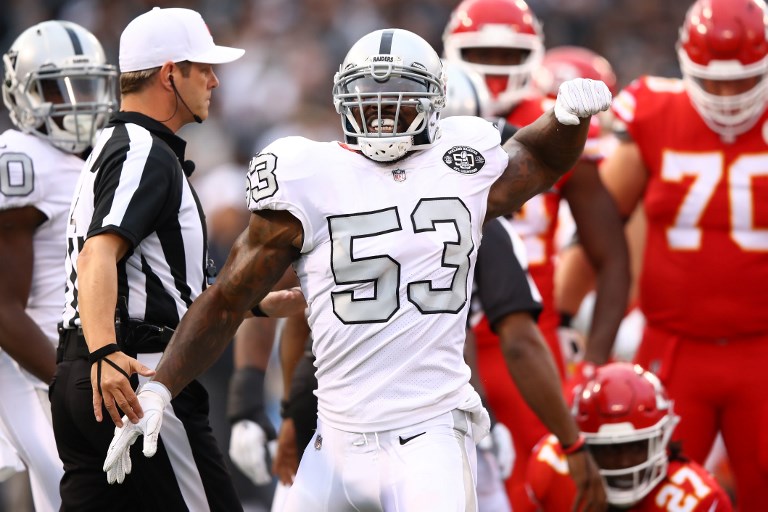
NaVorro Bowman #53 of the Oakland Raiders reacts after a play against the Kansas City Chiefs during their NFL game at Oakland-Alameda County Coliseum on October 19, 2017 in Oakland, California. Ezra Shaw/Getty Images/AFP
ALAMEDA, California — When NaVorro Bowman joined the Oakland Raiders days after being let go in a youth movement in San Francisco he made a proclamation.
“I’m only 29 years old and I still have a lot of juice left in me,” he said.
That Bowman even needed to make the case that a player still in his 20s wasn’t over the hill shows how much the game has changed since he entered the league in 2010. Players at ages once considered to be their prime playing years now struggle to find jobs.
The NFL has undergone a dramatic youth movement in the past decade as teams grow more inclined to go with cheaper, more inexperienced players ahead of seasoned veterans.
The change is a reflection of the collective bargaining agreement signed before the 2011 season that capped rookie salaries and limited the chances for young players to renegotiate deals they had outperformed.
“I thought the reason we supposedly changed the CBA was to keep veteran guys around, quote-unquote, but that hasn’t been what’s materialized,” said Washington cornerback DeAngelo Hall, who entered the league in 2004. “It’s been: go younger, go cheaper.”
While teams are still willing to shell out big money to quarterbacks, elite pass rushers, shutdown cornerbacks, a few dominant offensive linemen and some big-play receivers, they are filling out the rest of the roster with players mostly on rookie contracts. The current CBA capped rookie salaries for the first four years — and an extra fifth for first-round picks — with the idea that more money would be available to veterans on second and third contracts. But that wealth has only materialized for a minority of stars at key positions, with a large share of veterans getting left behind.
“Veterans are being passed over in favor of younger players who cost half as much and don’t even have a fraction of the experience,” said longtime agent David Canter. “Whenever that happens, regardless of profession, the quality of the product is going to decrease. The new CBA helped create this environment as owners duped the players and NFLPA into thinking that the savings on rookie contracts via an unnecessary rookie scale would be passed along to veteran players, with the union scoring the victory of less time in facilities in the offseason.”
Instead the reduced offseason practice time, elimination of training camp two-a-days, and the reduction of in-season padded practices in hopes of making the game safer have hurt the quality of play even more; young players get even less preparation.
The Raiders were a perfect example of how the move to go young can be detrimental. Despite a glaring need at linebacker in the offseason, general manager Reggie McKenzie refused to spend money to upgrade the position, allowing a proven veteran like Zach Brown to sign with Washington despite visiting Oakland first.
That decision backfired as the team struggled at the position and even was forced to use a pair of undrafted rookies because of injuries to other young players before signing Bowman last week to solidify the spot.
“Sometimes you need to have older guys on the team just to symbolize what level of play you have to play at in the NFL,” Bowman said. “Young guys come in the league and they don’t know. Coaches want to see so much and get so much out of those young guys that pressure takes over and they can’t do it. You need to have some veteran guys out there.”
There are just fewer of them around. The average age of players on opening day rosters has dropped from 26.6 years to 26 years in the past decade, with more than 55 percent of all snaps now taken by players age 26 or younger.
While aging quarterbacks like Tom Brady and Drew Brees get much of the focus, the rest of the league is getting younger around them. In nearly every major statistical category the percentage of production in the league coming from players age 25 and younger has risen significantly compared to a decade ago. Players in their 30s who used to serve as mentors for young players are becoming a dying breed.
“When I came in the league, it was a great thing to have older guys — Lawyer Milloy or Rodney Harrison type of guys — in your locker room, playing and making plays, because knowledge is power and those guys have seen it all,” Hall said. “When I was a young guy, there was a couple of 10-year veteran corners in my room. Nobody would know their names. But they were just veteran guys who knew the game, knew how to make plays.
Guys I leaned on to gain a lot of knowledge from. But you don’t have that now.”
Now the young guys are called on to do it all. The share of production from players age 25 and younger has shot up in the past decade. Nearly 60 percent of all yards rushing come from that age group compared to 42 percent in 2007.
That pattern is echoed across nearly all statistics, with the share of yards receiving for young players jumping from 37 percent to 48 percent; touchdowns rising from 41 percent to 51 percent; yards passing going from 22 percent to 32 percent; and tackles increasing from 39 percent to 48 percent as players on rookie contracts get more responsibility.
“I think that mentality has changed over the years, too,” said Bills linebacker Lorenzo Alexander, who entered the league as an undrafted player in 2005. “Because before you got in this league, no matter how good you were unless you were like a first-rounder, if you were a rookie, (coaches) didn’t trust you, didn’t like you. And I think that mentality has changed.”

